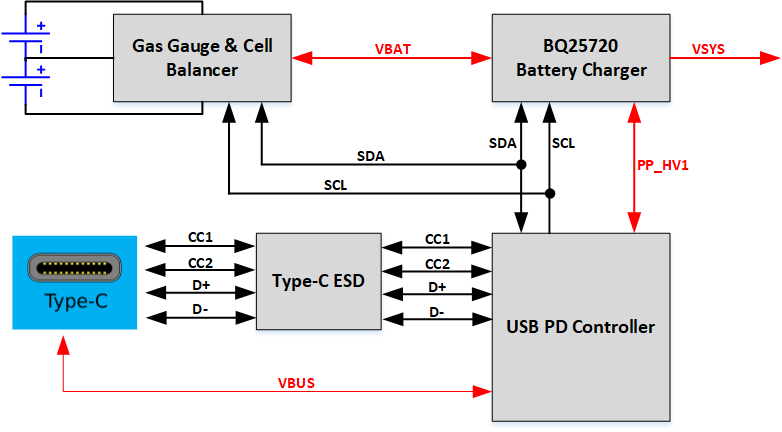SLUAAG7 October 2021 BQ25720
- Trademarks
- 1Introduction
-
2Design Considerations for Notebook
Applications
- 2.1 Vmin Active Protection (VAP)
- 2.2 Fast Role Swap (FRS)
- 2.3 Processor Hot Indication
- 2.4 Two-Level Battery Discharge Current Limit
- 2.5 Pass Through Mode (PTM) Operation
- 2.6 Seamless Mode Transition
- 2.7 Current and Power Monitor
- 2.8 Input Source Dynamic Power Management
- 2.9 Power Up USB Port From Battery (USB OTG)
- 3Test Results
- 4Summary
- 5References
1.1 Type-C Power Delivery (PD) Connection
Figure 1-1 shows a typical Type-C Power Delivery (PD) connection that includes three key components: USB PD controller, Battery Charger and Battery Gauging, respectively. USB PD controller controls all of the USB Type-C and PD negotiations, and also controls the battery charger over SMBus communication. This battery charger IC manages all the system output power and battery charging process. In addition, it works as a reverse buck-boost to provide power in on-the-go (OTG) mode. The gauging IC is used for cell balancing to ensure all battery cells remain at an equal voltage and manage battery pack status including capacity, voltage, current, and temperature for safety. Type-C ESD IC provides protection from electrostatic discharge (ESD) and VBUS to CC short.
 Figure 1-1 Type-C Power Delivery Connection
Block Diagram
Figure 1-1 Type-C Power Delivery Connection
Block Diagram